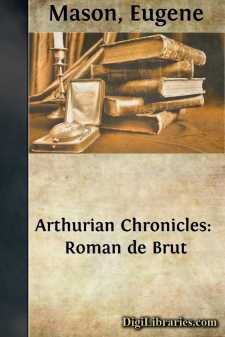Categories
- Antiques & Collectibles 13
- Architecture 36
- Art 48
- Bibles 22
- Biography & Autobiography 813
- Body, Mind & Spirit 142
- Business & Economics 28
- Children's Books 14
- Children's Fiction 11
- Computers 4
- Cooking 94
- Crafts & Hobbies 4
- Drama 346
- Education 46
- Family & Relationships 57
- Fiction 11829
- Games 19
- Gardening 17
- Health & Fitness 34
- History 1377
- House & Home 1
- Humor 147
- Juvenile Fiction 1873
- Juvenile Nonfiction 202
- Language Arts & Disciplines 88
- Law 16
- Literary Collections 686
- Literary Criticism 179
- Mathematics 13
- Medical 41
- Music 40
- Nature 179
- Non-Classifiable 1768
- Performing Arts 7
- Periodicals 1453
- Philosophy 64
- Photography 2
- Poetry 896
- Political Science 203
- Psychology 42
- Reference 154
- Religion 513
- Science 126
- Self-Help 84
- Social Science 81
- Sports & Recreation 34
- Study Aids 3
- Technology & Engineering 59
- Transportation 23
- Travel 463
- True Crime 29
Arthurian Chronicles: Roman de Brut
by: Eugene Mason
Categories:
Description:
Excerpt
I.вÐâWACE
In the long line of Arthurian chroniclers Geoffrey of Monmouth deservedly occupies the first place. The most gifted and the most original of their number, by his skilful treatment of the Arthurian story in his Historia Regum Britanniae, he succeeded in uniting scattered legends attached to Arthur's name, and in definitely establishing their place in chronicle history in a form that persisted throughout the later British historical annals. His theme and his manner of presenting it were both peculiarly adapted to win the favour of his public, and his work attained a popularity that was almost unprecedented in an age that knew no printed books. Not only was it accepted as an authority by British historians, but French chroniclers also used it for their own purposes.
About the year 1150, five years before the death of Geoffrey, an Anglo-Norman, Geoffrey Gaimar, wrote the first French metrical chronicle. It consisted of two parts, the Estorie des Bretons and the Estorie des Engles, of which only the latter is extant, but the former is known to have been a rhymed translation of the Historia of Geoffrey of Monmouth. Gaimar's work might possibly have had a longer life if it had not been cast into the shade by another chronicle in verse, the Roman de Brut, by a Norman poet, Wace, which fills an important and interesting place among our Arthurian sources, not merely because of the author's qualities as a poet and his treatment of the Arthurian story, but also because of the type of composition that he produced. For the metrical chronicle occupies an intermediate position between the prose chronicle, one of the favourite forms of mediaeval monastic production throughout Europe, and the metrical romance, which budded and blossomed most richly in France, where, during the last half of the twelfth century, it received its greatest impulse from Crestien de Troies, the most distinguished of the trouveres. The metrical romances were written for court circles, and were used as a vehicle for recounting adventures of love and chivalry, and for setting forth the code of behaviour which governed the courtly life of France at that period. Wace's poem, though based upon chronicle history, is addressed to a public whose taste was turning toward chivalric narrative, and it foreshadows those qualities that characterised the verse romances, for which no more fitting themes could be found than those supplied by the stories of Arthurian heroes, whose prowess teaches us that we should be valiant and courteous. Wace saw the greater part of the twelfth century. We cannot be certain of the exact year of his birth or of his death, but we know that he lived approximately from 1100 to 1175. Practically all our information about his life is what he himself tells us in his Roman de Rou:вÐâ
"If anybody asks who said this, who put this history into the Romance language, I say and I will say to him that I am Wace of the isle of Jersey, which lies in the sea, toward the west, and is a part of the fief of Normandy....


